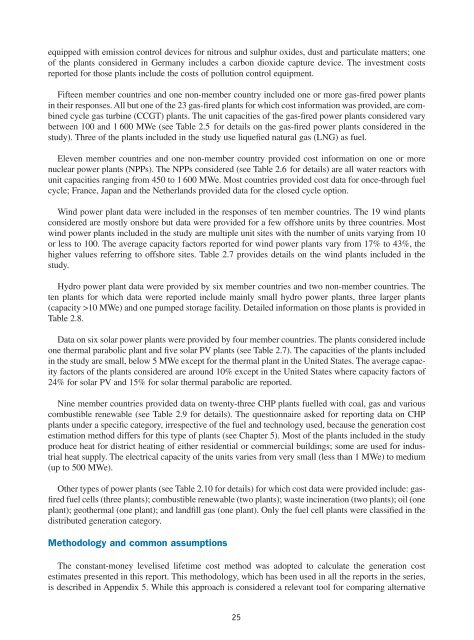Projected Costs of Generating Electricity - OECD Nuclear Energy ...
Projected Costs of Generating Electricity - OECD Nuclear Energy ...
Projected Costs of Generating Electricity - OECD Nuclear Energy ...
You also want an ePaper? Increase the reach of your titles
YUMPU automatically turns print PDFs into web optimized ePapers that Google loves.
equipped with emission control devices for nitrous and sulphur oxides, dust and particulate matters; one<br />
<strong>of</strong> the plants considered in Germany includes a carbon dioxide capture device. The investment costs<br />
reported for those plants include the costs <strong>of</strong> pollution control equipment.<br />
Fifteen member countries and one non-member country included one or more gas-fired power plants<br />
in their responses. All but one <strong>of</strong> the 23 gas-fired plants for which cost information was provided, are combined<br />
cycle gas turbine (CCGT) plants. The unit capacities <strong>of</strong> the gas-fired power plants considered vary<br />
between 100 and 1 600 MWe (see Table 2.5 for details on the gas-fired power plants considered in the<br />
study). Three <strong>of</strong> the plants included in the study use liquefied natural gas (LNG) as fuel.<br />
Eleven member countries and one non-member country provided cost information on one or more<br />
nuclear power plants (NPPs). The NPPs considered (see Table 2.6 for details) are all water reactors with<br />
unit capacities ranging from 450 to 1 600 MWe. Most countries provided cost data for once-through fuel<br />
cycle; France, Japan and the Netherlands provided data for the closed cycle option.<br />
Wind power plant data were included in the responses <strong>of</strong> ten member countries. The 19 wind plants<br />
considered are mostly onshore but data were provided for a few <strong>of</strong>fshore units by three countries. Most<br />
wind power plants included in the study are multiple unit sites with the number <strong>of</strong> units varying from 10<br />
or less to 100. The average capacity factors reported for wind power plants vary from 17% to 43%, the<br />
higher values referring to <strong>of</strong>fshore sites. Table 2.7 provides details on the wind plants included in the<br />
study.<br />
Hydro power plant data were provided by six member countries and two non-member countries. The<br />
ten plants for which data were reported include mainly small hydro power plants, three larger plants<br />
(capacity >10 MWe) and one pumped storage facility. Detailed information on those plants is provided in<br />
Table 2.8.<br />
Data on six solar power plants were provided by four member countries. The plants considered include<br />
one thermal parabolic plant and five solar PV plants (see Table 2.7). The capacities <strong>of</strong> the plants included<br />
in the study are small, below 5 MWe except for the thermal plant in the United States. The average capacity<br />
factors <strong>of</strong> the plants considered are around 10% except in the United States where capacity factors <strong>of</strong><br />
24% for solar PV and 15% for solar thermal parabolic are reported.<br />
Nine member countries provided data on twenty-three CHP plants fuelled with coal, gas and various<br />
combustible renewable (see Table 2.9 for details). The questionnaire asked for reporting data on CHP<br />
plants under a specific category, irrespective <strong>of</strong> the fuel and technology used, because the generation cost<br />
estimation method differs for this type <strong>of</strong> plants (see Chapter 5). Most <strong>of</strong> the plants included in the study<br />
produce heat for district heating <strong>of</strong> either residential or commercial buildings; some are used for industrial<br />
heat supply. The electrical capacity <strong>of</strong> the units varies from very small (less than 1 MWe) to medium<br />
(up to 500 MWe).<br />
Other types <strong>of</strong> power plants (see Table 2.10 for details) for which cost data were provided include: gasfired<br />
fuel cells (three plants); combustible renewable (two plants); waste incineration (two plants); oil (one<br />
plant); geothermal (one plant); and landfill gas (one plant). Only the fuel cell plants were classified in the<br />
distributed generation category.<br />
Methodology and common assumptions<br />
The constant-money levelised lifetime cost method was adopted to calculate the generation cost<br />
estimates presented in this report. This methodology, which has been used in all the reports in the series,<br />
is described in Appendix 5. While this approach is considered a relevant tool for comparing alternative<br />
25

















